Acoustic Guitar Tips And Articles
On this page you will find a variety of acoustic guitar tips and articles on how to play your acoustic guitar in the very best ways possible. Be sure to check these acoustic recources out and stop wasting time with a trial and error approach.
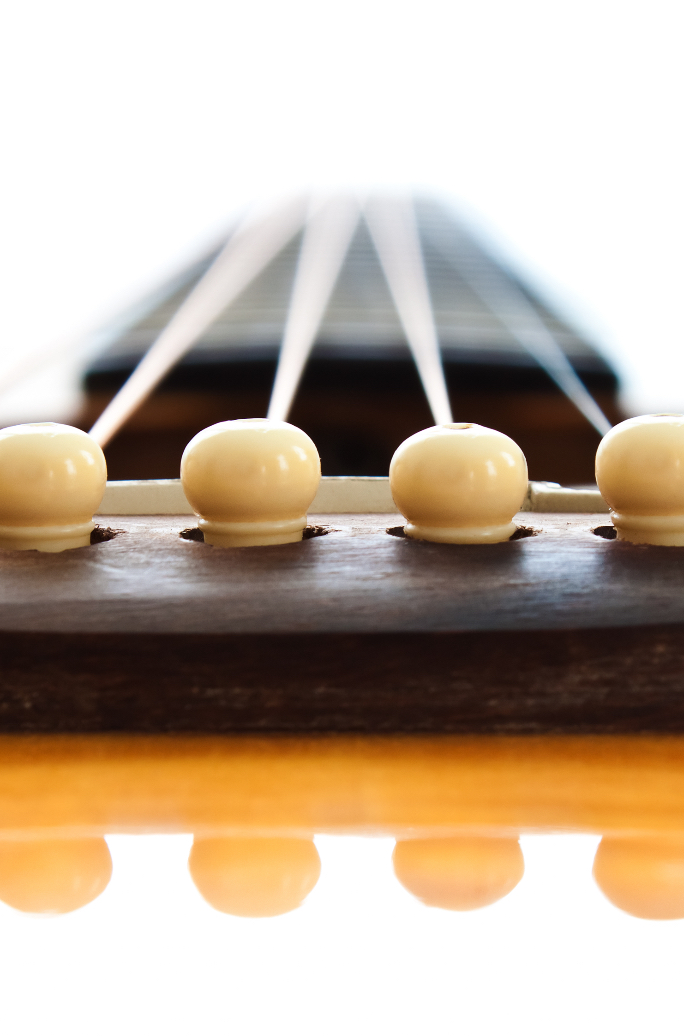 BRAND NEW! Ever learned a bunch of fingerpicking patterns on your guitar and found yourself clueless as to how to use them to create actual music?
BRAND NEW! Ever learned a bunch of fingerpicking patterns on your guitar and found yourself clueless as to how to use them to create actual music?
This is an all too common scenario where fingerpicking patterns are learned by the student, but the crucial step of transforming them into real music is not. Simply playing through fingerpicking patterns on guitar is boring.
Why?
Because learning the patterns is a step within a process, not the process itself. You don’t learn fingerpicking patterns to be able to play fingerpicking patterns. You learn them to be able to play music; unique, awesome, and incredible sounding music!
Learn how to transform fingerpicking patterns into incredible sounding music on your guitar
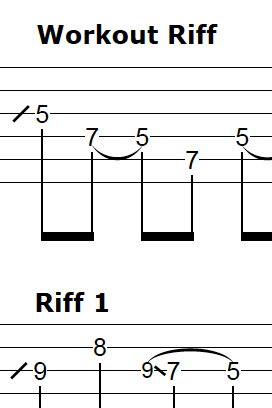 NEW: In this lesson I will reveal to you the remaining 4 steps of my 7 step guitar riff workout. Learning guitar riffs in isolation is just 1 step of the workout. There is more required if you are to create actual music with the riffs you learn on guitar.
NEW: In this lesson I will reveal to you the remaining 4 steps of my 7 step guitar riff workout. Learning guitar riffs in isolation is just 1 step of the workout. There is more required if you are to create actual music with the riffs you learn on guitar.
In this article I will show you how to span the length of the fretboard with a single riff so you can create incredible sounding music wherever you are on the neck of the guitar. You’ll learn and create with 3 different types of variations that can be applied to a riff allowing you to create mountains of music.
Best of all I will show you how to make sure the riffs you learn are at your finger tips when in the actual act of playing guitar.
It’s all part of the 7 step acoustic guitar riff workout lesson
 NEW: It can be incredibly frustrating when you invest the time into learning riffs of your favourite guitar players, with the intention of adapting them to use in your own soloing and improvisation, to then discover you can do anything but.
NEW: It can be incredibly frustrating when you invest the time into learning riffs of your favourite guitar players, with the intention of adapting them to use in your own soloing and improvisation, to then discover you can do anything but.
It took me a long time to realise that simply learning riffs in isolation will do very little for your own guitar soloing skills. Yes a riff in isolation can sound cool, but is totally wasted if you cannot draw upon it when actually engaged in the act of soloing on your guitar.
In part 1 of this lesson I am going to reveal to you the first 3 steps of my 7 step guitar riff workout. You will soon discover that simply learning a riff in isolation is only the very first step.
Learn how to transform guitar riffs into incredible sounding solos on your guitar
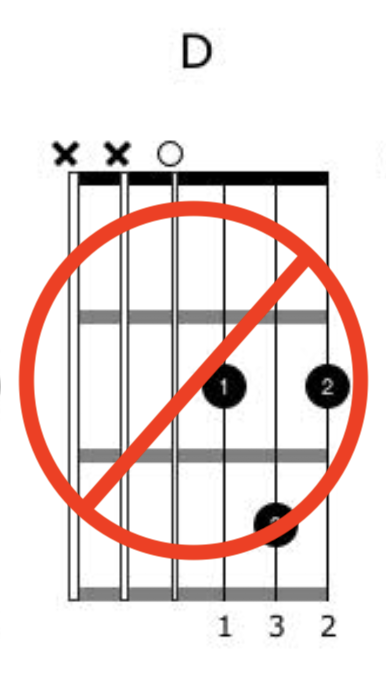 Can you take an average, everyday, common sounding chord progression and transform it into something totally unique and incredible sounding on your guitar?
Can you take an average, everyday, common sounding chord progression and transform it into something totally unique and incredible sounding on your guitar?
In this the 3rd and final video lesson in a series I’ve made for you on how to create amazing music using simple chord shapes on your guitar, I will show you how to do exactly this with two of the most common chord progressions you are ever likely to play on guitar.
Discover how to transform everyday chord progressions into awe inspiring music on your guitar
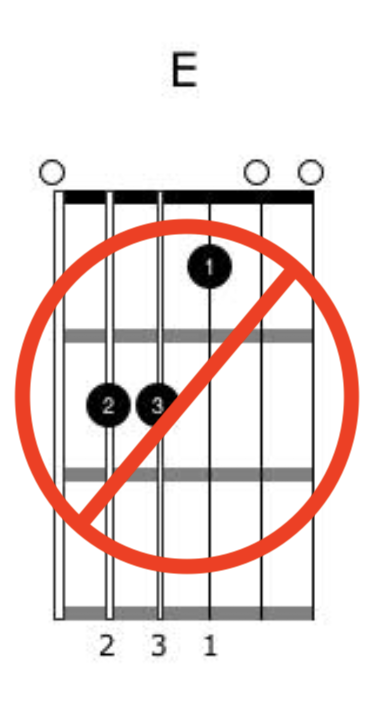 I’m sure if I told you in this lesson you will be repeating the same two chords over and over on your guitar, you wouldn’t be too inspired to check it out.
I’m sure if I told you in this lesson you will be repeating the same two chords over and over on your guitar, you wouldn’t be too inspired to check it out.
Pretty boring right?
Well if all you used were open chords, then yes I agree it would be very boring. However in this lesson you are going to ditch your open chords for much more exciting shapes that will open you up to a whole world of sound. I am going to reveal how you can easily generate hours of amazing, breathtaking music on your guitar playing the same chord change over and over again. You’ll be amazed at how much music exists within just one chord change.
Discover how to create hours of beautiful music with one guitar chord change
 How many different types/shades of the colour blue are there? If you are thinking what the hell does this have to do with guitar playing, bare with me for a moment.
How many different types/shades of the colour blue are there? If you are thinking what the hell does this have to do with guitar playing, bare with me for a moment.
There are many shades of blue right?
Well just like a single colour, there are many “shades” to the sound of a single chord too. Yet if all you know to play are open and bar chords on your guitar, you are but accessing just one shade of that chord, just one possible version, one possible sound that chord has to offer. There is SO much more!
Learn how to create unique and sophisticated music on your guitar playing just one chord
 Want to learn one of those fingerpicking guitar techniques that knocks the socks off of anyone within listening distance? The answer is Travis Picking! When you use this particular fingerpicking technique, it will sound more like 2, or even 3 guitars playing at once, instead of just 1!
Want to learn one of those fingerpicking guitar techniques that knocks the socks off of anyone within listening distance? The answer is Travis Picking! When you use this particular fingerpicking technique, it will sound more like 2, or even 3 guitars playing at once, instead of just 1!
In this masterclass video lesson I will show you how to use travis picking, as well as a proven method for applying this fingerpicking approach to any tune you want. It’s great to learn a particular style of guitar playing, but so much better when you can apply it yourself to any musical situation you find yourself in. That is when you have really learned something!
Discover how to create your own guitar fingerpicking arrangements using travis picking
 Looking to take your fingerpicking guitar skills to a whole new level? Once you have a solid foundation for fingerpicking, the next step is to apply these skills by creating fingerpicking arrangements of songs on your guitar. You know, the type of arrangements where you are playing the bass, harmony, and melody of a tune at the same time, on one guitar. Sound hard?
Looking to take your fingerpicking guitar skills to a whole new level? Once you have a solid foundation for fingerpicking, the next step is to apply these skills by creating fingerpicking arrangements of songs on your guitar. You know, the type of arrangements where you are playing the bass, harmony, and melody of a tune at the same time, on one guitar. Sound hard?
It doesn’t have to be. In this video/article I am going to show you a process I use when creating fingerpicking arrangements on my guitar. The end result sounds complicated, however if you follow my strategy, it is in fact quite simple and easy to do.
Learn how to easily create awesome sounding fingerpicking arrangements on guitar
 The sound of a walking bass line is synonymous with jazz music. It’s a great sound that people love hearing, even if they don’t know what it is exactly. Typically played on a bass, a walking bass line brings great momentum to a chord progression, with a forward like motion, hence the name “walking” bass. A walking bass line however, can also be played on a guitar. The added advantage here is that you can also add the chords of the progression too, for a truly amazing sound!
The sound of a walking bass line is synonymous with jazz music. It’s a great sound that people love hearing, even if they don’t know what it is exactly. Typically played on a bass, a walking bass line brings great momentum to a chord progression, with a forward like motion, hence the name “walking” bass. A walking bass line however, can also be played on a guitar. The added advantage here is that you can also add the chords of the progression too, for a truly amazing sound!
In this article I will show you how to easily create and play a walking bass line on your guitar, and play the chords of the progression at the same time too!
 Playing fast solos on your guitar can seem very difficult to do, especially if you are a beginner to early intermediate guitar player. Today however, I am going to show you some very cool fingerpicking riffs that will be easy for you to play fast on your guitar, in a relatively short amount of time. The reason why it will be easier to play these riffs faster than others, is because of the consistency of the patterns both your picking and fretting hands will be doing throughout. These fingerpicking riffs work equally well played at medium and slow speeds too. So if you’re not interested in playing fast solos on your guitar, these riffs will still be very useful for your acoustic guitar soloing.
Playing fast solos on your guitar can seem very difficult to do, especially if you are a beginner to early intermediate guitar player. Today however, I am going to show you some very cool fingerpicking riffs that will be easy for you to play fast on your guitar, in a relatively short amount of time. The reason why it will be easier to play these riffs faster than others, is because of the consistency of the patterns both your picking and fretting hands will be doing throughout. These fingerpicking riffs work equally well played at medium and slow speeds too. So if you’re not interested in playing fast solos on your guitar, these riffs will still be very useful for your acoustic guitar soloing.
Learn how to play fast fingerpicking riffs on your acoustic guitar
 All guitarist’s play and/or are influenced by the style of blues in some way. It’s a great style, a lot of fun to jam, and great for establishing a great foundation from which to solo and improvise on your guitar. As great as blues is, it can sound predictable, and at some point you will be looking for something to spice things up a little. Today, in the second of a two part video/article series I am going to show you how to create blues riffs that are totally unique and amazing in sound. There is no magic scale being used here. In fact, it’s one of the most common scales that exists. However, the technique I am going to show you, will turn this scale, and the riffs you create from it, into something like you’ve never heard.
All guitarist’s play and/or are influenced by the style of blues in some way. It’s a great style, a lot of fun to jam, and great for establishing a great foundation from which to solo and improvise on your guitar. As great as blues is, it can sound predictable, and at some point you will be looking for something to spice things up a little. Today, in the second of a two part video/article series I am going to show you how to create blues riffs that are totally unique and amazing in sound. There is no magic scale being used here. In fact, it’s one of the most common scales that exists. However, the technique I am going to show you, will turn this scale, and the riffs you create from it, into something like you’ve never heard.
Learn how to create totally unique and amazing fingerpicking blues riffs on your guitar
 Are you sick and tired of how your solos sound on guitar?
Are you sick and tired of how your solos sound on guitar?
I bet you use the pentatonic scale all the time, and as great as it can sound, it can also become tiresome and boring to use when it’s all you know to do, or tend to do, when soloing. I am going to show you a very cool and unique technique that will become a game changer for your guitar soloing. You will be creating all sorts of awesome solos, and all the while you will be using the good old pentatonic scale, only with a couple of other magic ingredients!
Learn a completely different way to use the pentatonic scale to create amazing sounding solos on your guitar
 The style of percussive guitar can be extremely challenging to play, however it doesn’t have to be. Simply learning a few basic percussive elements, and then combining these to play beats and grooves on your guitar is actually quite easy to do.
The style of percussive guitar can be extremely challenging to play, however it doesn’t have to be. Simply learning a few basic percussive elements, and then combining these to play beats and grooves on your guitar is actually quite easy to do.
Taking these beats and grooves and adding them to a chord progression is not a stretch either, even if you just have basic skills right now.
Learn how to easily play your acoustic guitar percussively with this video/article.
 Creating your own chord/melody arrangements on guitar, where you play the chords and melody of a song at the same time, is not so much a matter of having great skills, as it is having a great strategy and method in place in which to play this way. I did it the hard way by not having any strategy in place. It was time consuming and frustrating to say the least!
Creating your own chord/melody arrangements on guitar, where you play the chords and melody of a song at the same time, is not so much a matter of having great skills, as it is having a great strategy and method in place in which to play this way. I did it the hard way by not having any strategy in place. It was time consuming and frustrating to say the least!
Let me save you that unnecessary pain. In an earlier lesson I revealed to you 3 critical mistakes guitarists make when trying to play chord/melody style. Now I want to add to that a further 4 equally critical mistakes guitarists make when playing chord/melody style. By simply avoiding these mistakes yourself, playing and creating chord/melody arrangements on your guitar will become easy and fun to do!
Discover more common and critical mistakes guitar players make when trying to play chord/melody and how to avoid them in your own playing.
 The clawhammer fingerpicking pattern is perhaps the most commonly used, useful, applicable fingerpicking pattern for your guitar playing.
The clawhammer fingerpicking pattern is perhaps the most commonly used, useful, applicable fingerpicking pattern for your guitar playing.
Yet it will be totally useless to you, in any real life capacity at least, if all you do is learn the basic pattern. There is much more to mastering a fingerpicking pattern such as this, that meets the eye. It is a multi step process, where most people stop after step 1, believing they have got it, yet are left frustrated, wondering why they are struggling to make anything that resembles real music with it on their guitar.
Read this article, and discover how to truly master the clawhammer fingerpicking guitar technique so you can sound like the pro’s do when fingerpicking your guitar
 Ever tried creating and/or playing chord/melody arrangements on your guitar and failed miserably, finding it near impossible to play both the chords and melody of a song at the same time?
Ever tried creating and/or playing chord/melody arrangements on your guitar and failed miserably, finding it near impossible to play both the chords and melody of a song at the same time?
If you answered yes, you are definitely not alone!
It’s one of the most impressive and rewarding ways to play a guitar, but also one of the most challenging.
The great news is, you most likely don’t need to increase your guitar skills to play and create chord/melody arrangements, but rather avoid critical and common mistakes most guitar players make because they have no strategy or method in place when trying to play this style.
Learn how to avoid these critical chord melody guitar playing mistakes and easily create your own awesome sounding arrangements as a result!
 Ever wondered how your favourite players make fingerpicking their guitar look so easy to do?
Ever wondered how your favourite players make fingerpicking their guitar look so easy to do?
Truth is, a lot of the time there is a lot less going on than what meets the eye, or in this case, the ear. While many patterns exist in the world of fingerpicking, there is one in particular that is more prevalent than any other.
This fingerpicking pattern will provide you with the ability to play literally thousands of songs, as well as create your own fingerpicking masterpieces!
Learn the number one fingerpicking pattern for your guitar playing with this easy to follow, step by step, method I have laid out for you.
 If you are feeling unmotivated, uninspired, and just all round frustrated with your guitar playing right now, the great news is that times like these are often proceeded by your biggest growth and improvement as a player and musician!
If you are feeling unmotivated, uninspired, and just all round frustrated with your guitar playing right now, the great news is that times like these are often proceeded by your biggest growth and improvement as a player and musician!
Check this article out on ways to reignite your creativity and passion on guitar and learn how to take advantage of lean periods in your playing where you feel like you have plateau’d.
 Stuck in a rut with your acoustic guitar rhythm playing? It is very common to get caught up in a strum only approach when playing acoustic guitar. Truth is, given the right strategies and methods you can totally transform your acoustic rhythm guitar playing. You will have a new found freedom and even surprise yourself when you pick your guitar up to play.
Stuck in a rut with your acoustic guitar rhythm playing? It is very common to get caught up in a strum only approach when playing acoustic guitar. Truth is, given the right strategies and methods you can totally transform your acoustic rhythm guitar playing. You will have a new found freedom and even surprise yourself when you pick your guitar up to play.
Read this article on acoustic rhythm guitar and learn how to give your playing the makeover it needs so you never get bored with your own playing ever again!
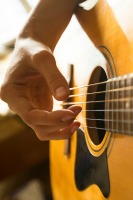 When it comes to playing guitar it is often said that there is the EASY way to do it and then there is the RIGHT way. It is the same when fingerpicking your acoustic guitar. Don't fall into the trap of going with what comes natural to you when trying to learn this style of playing on your own. There is every chance you will be going about it the wrong way. Don't waste your time!
When it comes to playing guitar it is often said that there is the EASY way to do it and then there is the RIGHT way. It is the same when fingerpicking your acoustic guitar. Don't fall into the trap of going with what comes natural to you when trying to learn this style of playing on your own. There is every chance you will be going about it the wrong way. Don't waste your time!
Check this article out on guitar fingerpicking technique to learn exactly how to go about getting the fundamentals of this style down the RIGHT way.
 Think that having the music/tablature to a song plus a recording of it is enough to get that song down from start to finish?
Think that having the music/tablature to a song plus a recording of it is enough to get that song down from start to finish?
Think again! Learning full songs on the guitar can be a massive frustration for many players. However it doesn't have to be. In order to learn the songs you love you must first have effective strategies in place to do this.
Read this article on exactly how to learn full songs on your guitar from start to finish and avoid the frustrations that come with learning songs ineffectively.
 The rhythm and timing of a song tends to be something that many guitar players think will just happen by default once they have the notes and chords down. This is NOT true, and as a result it is the cause of many guitar playing problems and frustrations.
The rhythm and timing of a song tends to be something that many guitar players think will just happen by default once they have the notes and chords down. This is NOT true, and as a result it is the cause of many guitar playing problems and frustrations.
Check this article out on how to play your guitar in time to be on your way to better guitar timing, and playing, today.
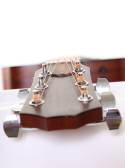
Part 2 of ways to inspire new found creativity and inspiration into your acoustic guitar playing. If you've ever felt like you have hit the wall with your guitar playing, and we all do, then check this article out where a further 3 ways are presented to you that will help reignite your creativity on the guitar.
You'll never feel bored or discouraged with your playing again when you discover these cool and unique ways to play your acoustic guitar
 When creating an unplugged version of an electric song on your acoustic guitar, you need to do more than simply copy the existing song, note for note, onto your acoustic. There are many things to consider and do to make your unplugged version sound awesome! The secret is to tap into the unique characteristics of the acoustic guitar, which in turn will provide you with ways to compensate for the electric guitar, and the other instruments in the song too, if you are playing solo (ie. just you and your guitar).
When creating an unplugged version of an electric song on your acoustic guitar, you need to do more than simply copy the existing song, note for note, onto your acoustic. There are many things to consider and do to make your unplugged version sound awesome! The secret is to tap into the unique characteristics of the acoustic guitar, which in turn will provide you with ways to compensate for the electric guitar, and the other instruments in the song too, if you are playing solo (ie. just you and your guitar).
Read this article on creating your own unplugged acoustic guitar song to learn how to do this.
 Chords are commonly associated with rhythm guitar playing. What is not so commonly known however, is that chords are also a great tool to use for soloing on your acoustic guitar. You may choose to use them a little, sprinkled amongst your single note lines, adding great depth and texture to your solos, or you may use them a lot, creating a full blown chord solo.
Chords are commonly associated with rhythm guitar playing. What is not so commonly known however, is that chords are also a great tool to use for soloing on your acoustic guitar. You may choose to use them a little, sprinkled amongst your single note lines, adding great depth and texture to your solos, or you may use them a lot, creating a full blown chord solo.
It’s up to you. One thing is for sure though, adding an element of chords to your guitar soloing will take your acoustic playing to great new heights.
Read this article on how to solo using chords on your acoustic guitar and add a whole new sound to your playing starting today!
 You know the feeling. We’ve all been there as guitar players before. You’ve hit the wall and are running low on inspiration and motivation, maybe even contemplating quitting all together. Stop!
You know the feeling. We’ve all been there as guitar players before. You’ve hit the wall and are running low on inspiration and motivation, maybe even contemplating quitting all together. Stop!
A great way to fuel your desire to play the guitar is to study the styles and techniques of your favourite players. This has helped me out of a flat spot many times and is a great way to expand and improve your own guitar playing in massively defining ways!
Learn how to go about this through studying the guitar playing style and techniques of Chet Atkins
 Interested in learning a whole bunch of cool and great sounding approaches to creating an unplugged version of a song?
Interested in learning a whole bunch of cool and great sounding approaches to creating an unplugged version of a song?
To become a better acoustic guitar player you need to carefully listen, observe, and learn from others. While this may seem like simple and obvious advise, it is also very powerful.
Observing and learning from what other players have done before you is like taking your own personal lesson from them in playing your guitar.
Check out these 5 awesome acoustic versions of songs that I have carefully analysed for you to get you started in creating your own cool unplugged arrangements.
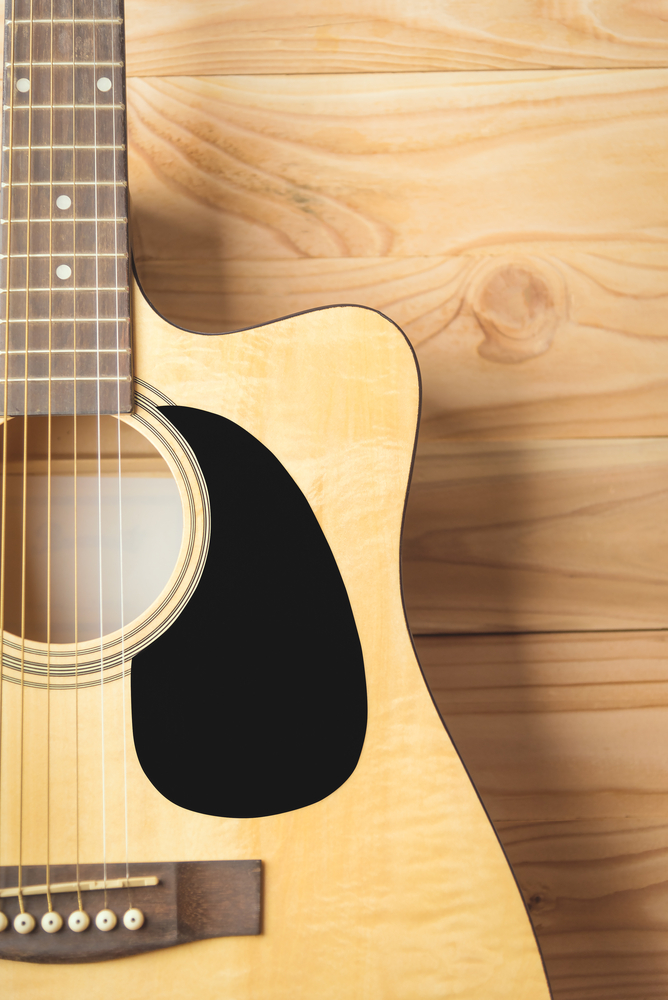 A great way to massively increase your creativity on the acoustic guitar is to transcribe music other instruments play. This will get you playing your acoustic in ways you would never have thought of, as all instruments are unique in how they sound and execute their notes. Great guitar players don't limit their listening and learning experiences to the guitar alone. They become great by listening carefully to other instruments, taking what they can and applying it to their own playing.
A great way to massively increase your creativity on the acoustic guitar is to transcribe music other instruments play. This will get you playing your acoustic in ways you would never have thought of, as all instruments are unique in how they sound and execute their notes. Great guitar players don't limit their listening and learning experiences to the guitar alone. They become great by listening carefully to other instruments, taking what they can and applying it to their own playing.
Learn how you can get started doing the same right now by arranging music from other instruments onto your acoustic guitar
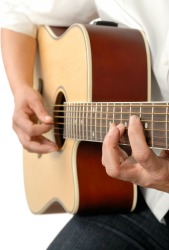 Picture this, you’re jamming the blues and you’ve just played an awesome solo. It’s now your turn to play the rhythm.
Picture this, you’re jamming the blues and you’ve just played an awesome solo. It’s now your turn to play the rhythm.
What are you going to do?
Hopefully not play the same old boring open chords. Having strong rhythm guitar skills is essential in becoming a great guitarist, yet many players ignore this area of their playing.
Learn some great ways to spice up your acoustic blues rhythm guitar playing. Everyone will want to jam with you!
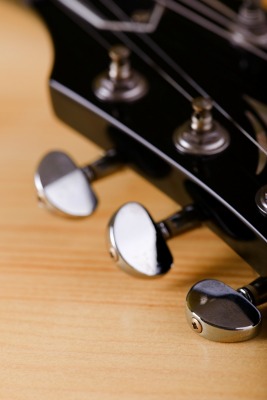 Are you a “one tuning wonder?”
Are you a “one tuning wonder?”
Do you purposely stick to standard tuning with everything you play on guitar, unwilling to try anything new, sighting that it’s too hard learning to play guitar in multiple tunings?
I mean, why go turn everything upside down by changing the tuning of your guitar.
This was my attitude in the early years of my playing, however I am so grateful I saw the light and discovered the magic of open tunings for my acoustic guitar playing.
Open tunings, or any kind of tuning for that matter, are designed to make things easier to play on guitar. In a lot of cases, things you can do in open tunings aren’t even possible to do in standard tuning.
Let me show you 5 easy things you can start doing right now to make open tunings part of your acoustic guitar playing.
 I want to show you a technique for your acoustic guitar playing that totally blew me away when I first heard it. I couldn’t believe the sound I was hearing was actually coming from a guitar! This technique is commonly known as harp harmonics or cascading harmonics. Whatever you want to call them, these will change the way you approach your acoustic guitar playing from the day you first start learning them.
I want to show you a technique for your acoustic guitar playing that totally blew me away when I first heard it. I couldn’t believe the sound I was hearing was actually coming from a guitar! This technique is commonly known as harp harmonics or cascading harmonics. Whatever you want to call them, these will change the way you approach your acoustic guitar playing from the day you first start learning them.
Don't be mistaken, harp harmonics are no “one trick pony”. They are extremely musical in their application. What you can do with them and the scope they offer your acoustic guitar playing is huge! Let me show you how to get started playing harp harmonics on your acoustic guitar right now!
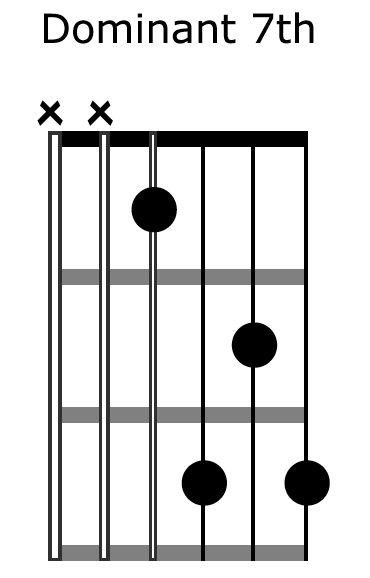 Knowing your open and bar chords is good. However if this is all you know when it comes to chords on your guitar then this is NOT good. In fact, it’s restricting your playing big time in ways you’re not even aware of!
Knowing your open and bar chords is good. However if this is all you know when it comes to chords on your guitar then this is NOT good. In fact, it’s restricting your playing big time in ways you’re not even aware of!
Many years ago I had this problem myself. I was a decent guitar player however when it came to chords, my knowledge and application of them on the instrument was poor. Translated, this means I only really knew my open and bar chord forms.
Let me show you what got me out of this rut I found myself in with these easy to play, advanced sounding guitar chords
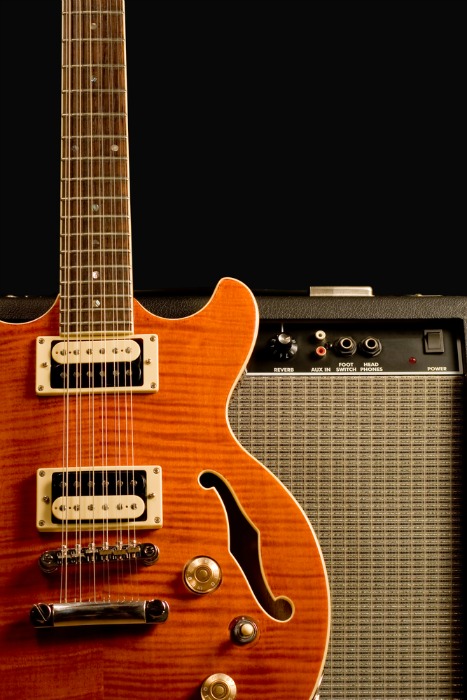 What do all great guitar players do?
What do all great guitar players do?
Answer: They look outside of their chosen style of music for inspiration and ideas they can apply musically to their own genre and way of playing. This is a key ingredient to becoming a great guitar player!
In fact, if I did not do this myself, there would be many, many things I simply would not be able to do that I CAN thankfully do now, within my own style.
Check out these 5 areas of jazz that will make you a better acoustic guitar player. You may even find jazz becomes another string to your bow regarding your guitar playing.
 One of the great things about open tunings is the whole new sound spectrum that is available for your guitar playing.
One of the great things about open tunings is the whole new sound spectrum that is available for your guitar playing.
One great beneficiary to open tunings are your chords. Whether it be the unfamiliar, but lush sound of the droning open strings against fretted notes, or the single fret bar chords that allow you to add extensions and embellishments not possible in standard tuning, open tunings will bring a whole new world of creativity to your guitar playing which can immediately take your playing to a much higher level.
Check out this article to learn creative ways to play chords in an Open G tuning on your guitar.
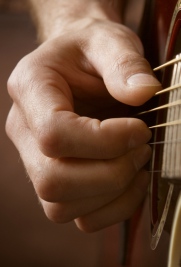 In this video/article lesson I am going to show you a very cool, easy, yet advanced sounding way to fingerpick the blues on your acoustic guitar. This fingerpicking technique will have you playing both the rhythm and lead parts to your blues at the same time, much like a pianist provides both the chords (left hand) and melody (right hand) to the pieces they play.
In this video/article lesson I am going to show you a very cool, easy, yet advanced sounding way to fingerpick the blues on your acoustic guitar. This fingerpicking technique will have you playing both the rhythm and lead parts to your blues at the same time, much like a pianist provides both the chords (left hand) and melody (right hand) to the pieces they play.
Better yet, this technique is simple to do!
Learn exactly how to go about creating your own acoustic fingerpicking blues arrangements on your guitar with this easy to follow method I have set out for you.